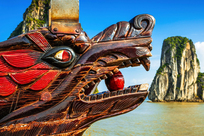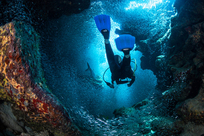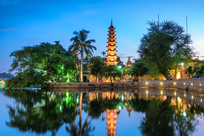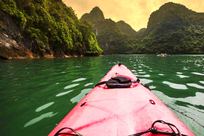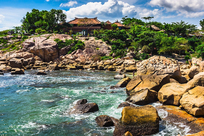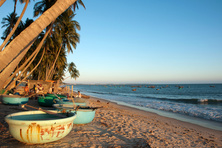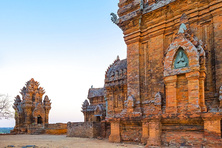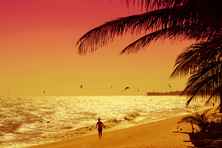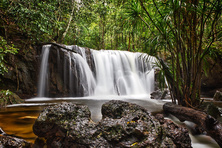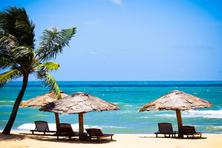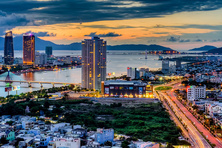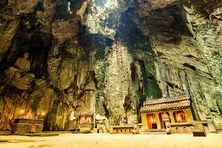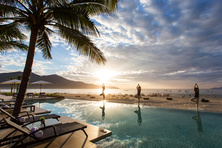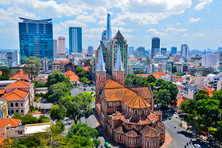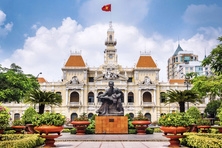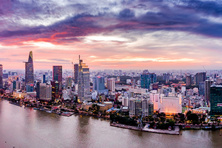Vietnam
- Capital:Hanoi
- Currency: Vietnamese dong
- Time: UTC+7
- Languages: Vietnamese
- Religions: followers of local animistic cults, Buddhism, Christianity, atheism
- Sections: Get in Visa Customs Cuisine Money Details of interest Popular resorts
The Socialist Republic of Vietnam is a state in Southeast Asia on the eastern part of the Indochinese peninsula. The country borders Cambodia, Laos and China. On the east and south, Vietnam is washed by the South China Sea. The capital city is Hanoi.
On the major part of the country the climate is monsoon tropical, on the north it is subtropical and on the south the climate is sub-equatorial. The best time for traveling to Vietnam is a dry season, which lasts from January to February.
The official language is Vietnamese. The majority of the population still follows the local traditional beliefs and religious cults, but because there are many Buddhist temples in the country, many people wrongly think that this is a Buddhist country.
The foreigners choose Vietnam because of the sea, ancient monuments of civilization, picturesque mountain routes and exotic cuisine.
Beach resorts are located all along the coastline and on the islands the largest of which is Vung Tau, Con Dao Islands, Quy Nhon, Ninh Thuan, Nha Trang, Phu Quoc island, Tuy Hoa, Phan Thiet, and Ham Thuan Nam.
Vietnam is considered to be one of the cheapest countries, but it is very interesting and offers good conditions for diving. The most popular places for diving are Nha Trang, Hoi An, Con Dao Islands and Phu Quoc.
Ecological tourism is also very popular in Vietnam. Dak Lak Province and Hoa Binh Province, the city of Dalat and Lao Cai are good destinations for biking and horse-riding.
In Vietnam, there are many historical monuments which present a great interest for the tourists. The centers of excursion tourism are Haiphong, Hanoi, Ho Chi Minh City, and Da Nang.
The fans of sport fishing gather near the lakes and rivers in the Mekong Delta.
Get in
By Plane
Major international airports are in Hanoi, Da Nang, and Ho Chi Minh. There are direct flights to these Vietnamese cities from Moscow, Saint Petersburg, Vladivostok, Paris, Frankfurt, and London. The tourists can also take transit flights with a stop in China or Thailand.
By Land
One can get to Vietnam by car or by bus from the territory of neighboring countries. There is an everyday train running between China and Vietnam.
Visa
The tourists from Belarus, the United Kingdom, Germany, Denmark, Spain, Italy, Norway, Russia, Finland, France and Sweden can stay in Vietnam for 15 days or less visa-free. A 30 days visa-free regime is also valid for the citizens of Kyrgyzstan.
The tourists from other EU and CIS countries must obtain a visa at the Embassy or online. To get an e-visa, it is necessary to fill in the form on a web resource and on arrival at the airport, the visa will be issued within 20-40 minutes. This service is available only in one airport.
The time for processing the documents for a visa at the Embassy is 7-8 working days. One can submit the documents personally or through a trusted person.
Customs
The Vietnamese law prohibits the export of the national currency, but there are no restrictions concerning the import and export of foreign currency. The sum exceeding 3.000 US dollars must be declared. It is also necessary to declare imported consumer electronics and digital gadgets because of the export of undeclared equipment a fee is charged. If you bought some gadgets in Vietnam, you should show the sales receipt.
The tourists can bring in Vietnam the following goods duty-free:
- a small amount of alcohol and tobacco;
- some tea and coffee;
- perfume for the personal use;
- personal belongings (the total cost of which must not exceed 5.000.000 dongs).
It is not allowed to import:
- potent medications without a doctor’s prescription;
- printed, audio and video materials insulting the local traditions.
It is not allowed to export from Vietnam:
- antiquities and art objects;
- jewelry and arts and crafts without a sales receipt.
Cuisine
The Vietnamese cuisine has many things in common with the cuisines of the neighboring countries, but still it has its own local twist. The staple food in Vietnam is rice, noodles, and seafood.
We recommend trying such meat dishes as Bo La Lot (grilled beef wrapped in pepper leaves), Bo Kho (beef and vegetable stew) and Thit Kho (pork stew with caramel sauce and eggs).
Poultry is the main ingredient for Ga Nuong Sa (grilled chicken with herbs), Goi Ngo Sen (chicken and shrimp salad with lotus) and Gai Ga (boiled chicken with cabbage).
Almost all soups in Vietnam are noodle soups. The tourists should try Pho (traditional noodle soup with beef broth), Bun Mang Vit (duck soup with bamboo shoots), and Bun Rieu (crab and tomato soup with a shrimp sauce).
Your holidays in Vietnam will be incomplete if you do not try fish and seafood dishes. For example, Canh Chua (sour seafood soup with vegetables), Ca Kho To (caramelized fish stew), Banh Hoi Tom (rice noodles with crab, lobster or shrimps), and Ca Ran Chua Ngot (fried fish with sour and sweet sauce).
Of course, you will not avoid rice Vietnamese dishes as rice is the main site here. The most popular dishes are Com Go Rau Thom (rice with roast chicken), Com Hen (rice with mussels), Banh Trang (rice paper rolls), and Cha Gio (deep fried rice paper rolls with various fillings).
For a dessert, you will be offered Che (a Vietnamese version of pudding), Rau Cau (jelly dessert), and Chuoi Chien (fried bananas with vanilla ice-cream).
At the end of the meal, the locals drink jasmine green tea, Ca Phe Sua Da (cold coffee drink), Nuoc Mia (sugar cane juice with ice), and Rau Ma (Centella drink with ice and sugar).
The Vietnamese make beer Bia Hoi and rice vodka Ruou De. Medicinal liquors with snakes Ruou Thuoc are very popular in Vietnam.
Money
The official currency is Dong (VND). The State Bank of Vietnam (Ngan Hang Nha Nuoc Viet Nam) issues bank notes from 100 to 500.000 dongs and coins from 200 to 5.000 dongs.
The tourists can exchange currency at banks, in exchange offices and on the markets where the rate is the best. You can pay with US dollars and sometimes with Euros almost everywhere. In large cities, the sellers accept yuans, yens and bahts.
Credit cards are accepted in all touristic places and also in some small shops and cafes. It is cost saving to pay with the card only if there are dongs otherwise, it is better to pay with cash.
There are many ATMs in Vietnam at banks, in large stores, and in hotels. The ATMs give only dongs.
The traveler’s checks in Euros and dollars are accepted at large banks.
In Vietnam, the tax-free system is available. The tourists can refund the VAT (around 10%) if they purchased the goods for the total cost of 95 US dollars. To refund VAT, they should apply to the tax-free office at the airport.
Details of interest
Sightseeing in Vietnam
In Vietnam, there are eight UNESCO sites:
- Hue Imperial City consists of several hundred historical objects built during the rule of the Nguyen dynasty.
- Hoi An Ancient City is an example of a very well preserved 15th - 19th port town in Indochina.
- My Son Sanctuary is the remains of the temple complex 50 km to the west from Hoi An. This is all that is left from the capital city of the medieval Chapa Empire.
- Halong Bay is a very picturesque coastal landscape with scattered islands. Many tourists come to Vietnam to see it.
- The Phong Nha-Ke Bang National Park in the Quang Binh Province. This park covers the most ancient karst area in Asia. In the park, there are around 3 hundred caves and grottos including the largest cave Son Doong.
- The Imperial Citadel of Thang Long is a medieval castle of the 11th century built on the ruins of the Chinese castle which was built earlier in the 7th century. During 13 centuries, the citadel served as the main political center of Indochina.
- The Citadel of the Ho Dynasty in the Thanh Hoa Province. This is the castle of the 14th century built according to the feng shui principles. It demonstrates the blooming of the neo-Confucianism in Vietnam and is an example of the architectural style of the Empire capital city.
- The landscape complex Trang An Grottoes in the Ninh Binh Province. This is a very picturesque place with fantastic limestone peaks and valleys.
Being in Vietnam, you should not miss a chance to visit, at least, one of the seven UNESCO candidate sites. The most interesting of them are:
- The Ba Be National park and the karst lake in the Bac Kan Province.
- Sapa Ancient Rock Field. The petroglyphs were carved here on the huge stones 2.000 years ago.
- The Cat Tien National Park. This is a very large reserve, which is divided into three absolutely different parts: Cat Loc, Nam Cat Tien, and Tay Cat Tien.
Do not ignore any other sights and places in Vietnam though they have not been included in the World Heritage List. The tourists like to visit the Cai Rang Floating Market in the city of Can Tho and Chau Doc in the Mekong river. Visit the President Ho Chi Minh Native Home in the Nghe An Province.
Vietnamese Souvenirs
In Vietnam, the travelers usually buy:
- traditional Asian conical hats;
- snake liquors;
- beautiful Vietnamese silk;
- delicate jewelry;
- coffee.







